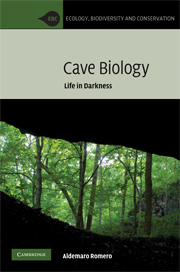Book contents
- Frontmatter
- Contents
- Preface
- Acknowledgments
- 1 A brief history of cave biology
- 2 Cave biodiversity
- 3 The evolutionary biology of cave organisms
- 4 The ecology of cave organisms
- 5 Cave conservation and management
- 6 Epilogue
- Appendix 1 Glossary of terms frequently used in biospeleology
- References
- Index
- Plate section
5 - Cave conservation and management
Published online by Cambridge University Press: 21 October 2009
- Frontmatter
- Contents
- Preface
- Acknowledgments
- 1 A brief history of cave biology
- 2 Cave biodiversity
- 3 The evolutionary biology of cave organisms
- 4 The ecology of cave organisms
- 5 Cave conservation and management
- 6 Epilogue
- Appendix 1 Glossary of terms frequently used in biospeleology
- References
- Index
- Plate section
Summary
This chapter deals with what has been learned so far regarding conservation, legal protection, and management (including the little known about restoration) of cave habitats. This issue is examined from habitat, species, population, and genetic perspectives.
Introduction
Caves and associated ecosystems (mostly karst) represent resources of great value. These values can be grouped into three general clusters: ecologic–scientific, economic, and cultural.
As described in previous chapters, caves have attracted the interest of researchers for many centuries. They provide a wealth of information not only about biodiversity and their intrinsic processes such as ecology and evolution, but also about geology, paleontology, chemistry, archaeology, and history.
From the economic viewpoint the importance of karstic areas is overwhelming: more than 25% of the world's population either lives on or obtains its water from karst aquifers. In the United States alone, 20% of the land surface is karstic in nature and 40% of the groundwater used for drinking comes from karst aquifers. Every year about 20 million tourists visit caves worldwide. This activity brings economic well-being not only to cave owners but also to the surrounding communities. In karstic areas a number of other human activities of economic importance take place: agriculture, mining (including guano extraction), animal breeding, and fungus cultivation, as well as the exploitation of biological resources such as the harvesting of cave swiftlet and oilbird nests. Some caves are also used as sanatoria in the belief that they can cure respiratory conditions.
- Type
- Chapter
- Information
- Cave BiologyLife in Darkness, pp. 182 - 208Publisher: Cambridge University PressPrint publication year: 2009
- 2
- Cited by



